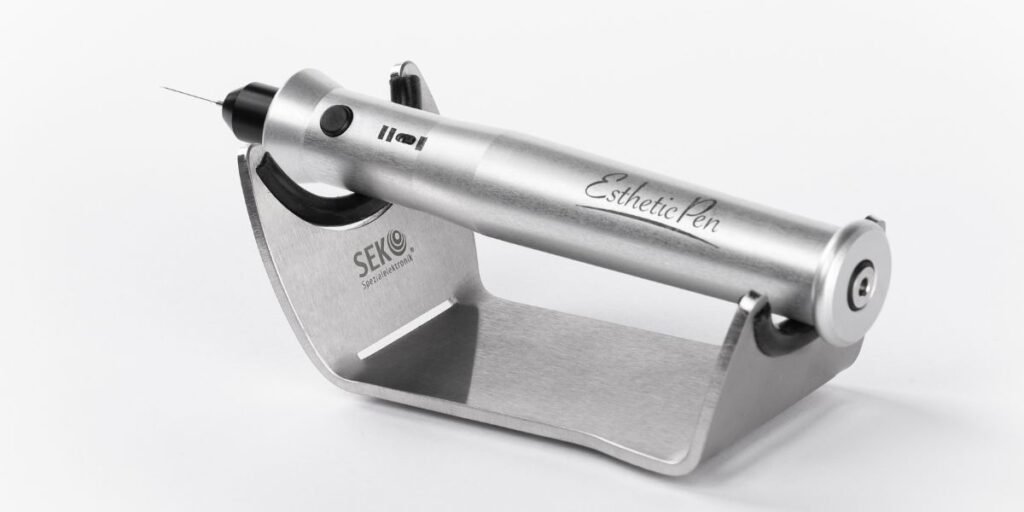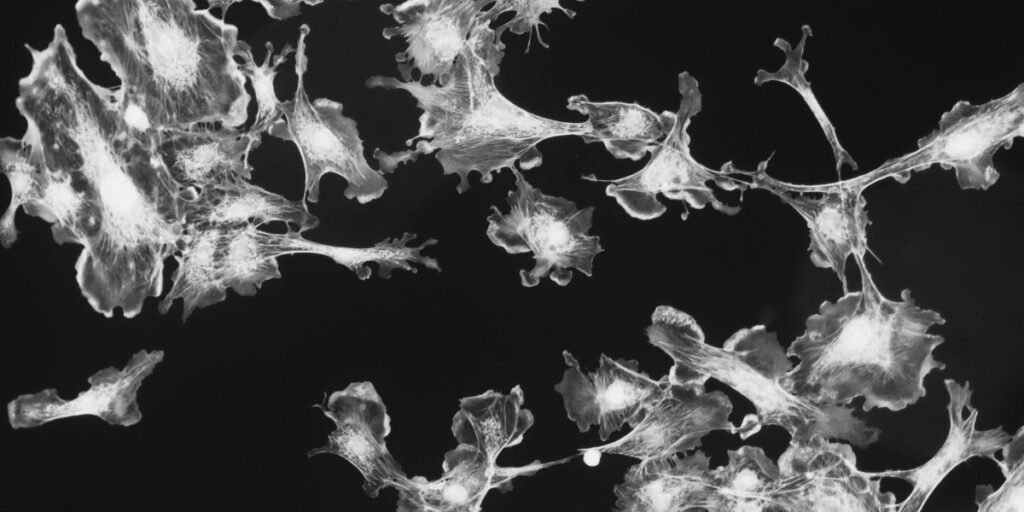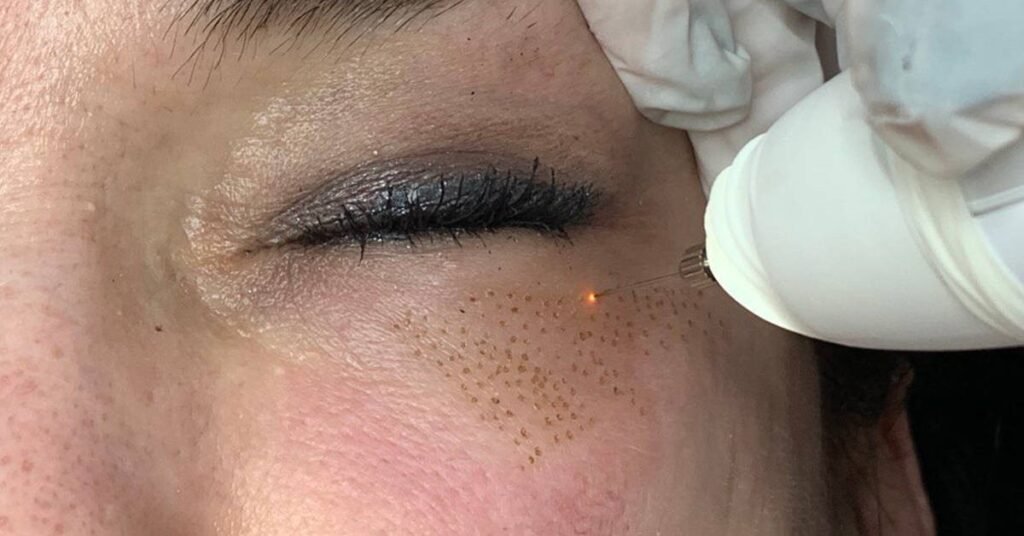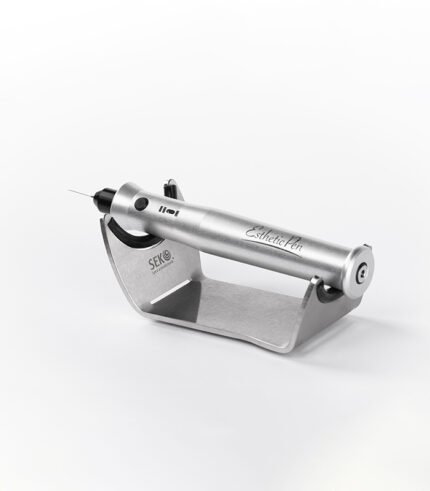Why fibroblast plasma pen is trusted by estheticians worldwide
What is a plasma pen?

A plasma pen is a device that bears a similarity to a mechanical toothbrush. Where the brush head would be, there’s a needle-like tip. This tip doesn’t actually touch the skin — it is the medium through which a plasma arc passes.
Plasma is sometimes called the fourth state of matter, and it forms when a gas is superheated. This causes the electrons to begin to detach from the atoms and move freely, which leads to an ionized gas – a gas where all the particles carry an electric charge. A plasma pen uses electricity to ionize the oxygen and nitrogen in the air. This produces a plasma arc about one millimeter from the skin surface.
Why use a plasma pen on skin?
The plasma arc acts to vaporize any liquid at the point where it hits the skin. This causes the surrounding skin to tighten around that point. Furthermore, it produces a superficial, controlled lesion to the epidermis, the upper layer of skin. The process of having the plasma pen generate these tiny lesions is repeated over the entirety of the desired treatment area.
In addition to causing skin tightening, the trauma from these lesions induces the production of collagen and elastin, both of which naturally lead to firmer skin. This is not a new process, as it is the basis for microneedling, a procedure where pinpricks in the skin cause cells to go into repair mode. These cells are called fibroblasts.
What are Fibroblasts?

Fibroblasts are cells whose function is to produce collagen, elastin, and growth factors. All of these are responsible for strengthening the skin’s connective tissue, which decreases considerably over the years. This is why a plasma pen is often called a fibroblast plasma pen. New collagen is formed over four to eight weeks, resulting in tighter, smoother and younger-looking good skin.
How does plasma pen work?

The innovative plasma pen device employs advanced plasma technology to achieve consistent outcomes. By ionizing atmospheric gases, plasma is generated, which prompts immediate contraction and firming of skin fibers and encourages collagen production during the procedure. This approach eliminates the need for a scalpel or laser to eliminate excess skin, thus minimizing the risks associated with both invasive and non-invasive cosmetic treatments.
The plasma pen treatment involves creating pinpoint-sized marks at specific intervals to instantly contract and tighten the skin’s fibers. These spots vaporize the outer skin cells without harming the underlying layers or causing bleeding. Notably, the surrounding and deeper tissues remain undamaged.
Although the aging process can’t be completely paused by plasma pen treatment, its results are long lasting. Subsequent lines and wrinkles that develop in patients after the initial treatment typically only necessitate a brief touch-up.
Stages of plasma pen fibroblasting process
STAGE 1
The precise plasma arc induces instant minor injuries to the outermost layer of the skin's epidermis.
STAGE 2
The small injuries trigger the body's healing mechanism, leading to the development of fresh, revitalized, firm, and silky skin tissue within the following 12 weeks.
STAGE 3
After the procedure, the skin generates collagen and elastin which enhance the skin's stricture, resulting in a smoother appearance and the reduction of lines and wrinkles.
What can you treat during fibroblast treatment?
Fibroblast treatment with the use of a plasma pen can be carried out on any part of the body, but the most common areas are the face and neck. It’s an excellent option for:
– Improving the appearance of acne scars;
– Erasing the folds around the corners of the mouth;
– Eliminating smoker’s lines;
– Improving wrinkles in the neckline and forehead;
– Treating expression lines;
– Refining and reducing the size of stretch marks;
– Improving sagging around the navel caused by pregnancy;
– Removing moles and warts;
– Tightening the jawline;
– Lifting eyebrows and correcting asymmetrical eyebrows;
– Improving wrinkles around the lips;
– Reducing hyperpigmentation (age spots);
– Getting rid of bags, wrinkles and loose skin under eyes;
– Lifting droopy eyelids;
– Reducing the look of crow’s feet.
The final three procedures constitute one of the most exciting things about the plasma pen. Due to the effect of skin contraction, fibroblast treatment can be used to remove excess skin around the eyes and to repair droopy eyelids. These are the same results you would get with a blepharoplasty, a type of surgery to improve the eyelids. But, of course, fibroblast treatment with the use of a plasma pen is non-surgical and noninvasive.
Fibroblast treatment advantages
These are among the many benefits of fibroblast treatment:
First, there are no injections or incisions.
Second, it’s cheaper than surgery.
Third, there are no stitches.
Next, as a noninvasive treatment, it requires a little downtime.
Moreover, the skin rejuvenation results are cumulative and long lasting.
Healing is fast and the risk of treatment difficulties is minimal. The results are natural looking and don’t produce changes in facial expressions.
And the most important fact is that it can be done on various areas of the body.
How is fibroblast treatment carried out?
The plasma pen practitioner first cleanses the skin and then because everyone has a different tolerance for pain, they apply a topical anesthetic cream. After about 30 minutes, this numbing cream will have taken effect and the practitioner can proceed to treat the specific area of concern. The plasma pen will create plasma arcs in a series of points on the treatment area that will form small crusty dots on the skin. The procedure generally takes between 30 and 60 minutes.
Results may possibly be seen immediately after the first session, but bear in mind that the small scabs will take about a week to fall off naturally. This will leave a slight redness that gradually diminishes over one to two months. During this phase, it’s fine to apply makeup and generally go back to your normal life, but it’s highly recommended that you avoid swimming pools and also saunas and other sources of excessive sweating. Over the next few weeks, as skin heals, it will feel firmer and smoother. It’s advisable to book another session three months after the first, although it might not be necessary. After about eight weeks, you’ll be able to see the final effect, and the results can last between one and three years.
Are all fibroblast plasma pens alike?
Not all plasma pens are quality products. One of the most important things to check is whether the pen is a cheap knock-off made in China. A low-quality pen may not be a true fibroblast plasma pen. Instead of creating plasma, it might just produce an electrical arc whose heat is not controlled. Plasma makes the epidermis go from a solid to a gas and then stops. That’s why the heat doesn’t spread to the surrounding area. With a cheap fibroblast plasma pen, you might be receiving unregulated heat that can cause burning and scarring.
And above all, remember that fibroblast treatment with a plasma pen is a technique that should be performed only by trained professionals, not only to have the best results, but also to protect your health.
Read comprehensive and extensive Practitioners FAQs & Patients FAQs to fully understand all the Ins and Outs of the fibroblast treatment and only then 👇

